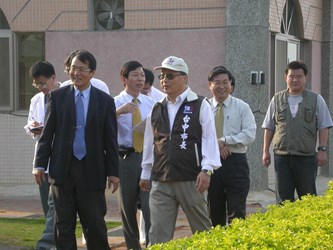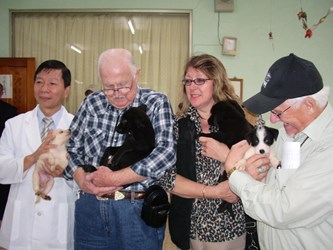Reasons for hosting an international forum in Taiwan
On December 11, 2006, a major annual event for the conservation community in Taiwan, namely the 2006 International Companion Animal Welfare Forum: a Dialogue between Taiwan and the World, commenced in Taipei City. This international forum was hosted by the Animal Protection Association of the Republic of China. Scholars and specialists from different animal protection groups in the United States, the United Kingdom, Australia, Korea and Japan were invited to participate in this forum. On one hand, it allowed animal protection groups from participating countries to learn about the progress of the animal protection in Taiwan, and encouraged them to understand the thought patterns and implementation approaches applied to animal welfare in Taiwan. On the other hand, the forum also helped people who are in the same field in our country to absorb and learn animal protection concepts and practices from more advanced countries, and then use them as reference for future animal protection planning for civil groups as well as for government.
In this international forum, in addition to discussions among animal protection activists, another important activity was to visit the most representative animal protection institution in Taiwan. The Taichung City Animal Health Inspection Office has promoted numerous animal protection activities in recent years. Therefore, it was selected as the representative institution for animal protection in Taiwan and a visit was arranged by the forum host. This visit offered a rare opportunity for the staff at the Taichung City Animal Health Inspection Office to have a dialogue with many animal protection specialists and scholars from many countries, such as Captain Jack Jones, an animal control officer from the United States; Rev. Vern Ballard from the American Humane Society; Dr. Kersti Seksel, a specialist in animal behavior from Australia; Dr. Deepashree Balaram, a specialist from ACTAsia; Dr. Kate Blaszak, a specialist in dealing with stray cats in the United Kingdom; Dr. Chizuko Yamaguchi, a representative from the Japan Animal Welfare Society; and Dr. Jin Suk Kim, a Korean specialist on animal protection. A visit to the Taichung Animal Shelter was also arranged so that visitors could better understand and observe the environment and the attitudes toward caring for stray animals at the shelter.
Visit to the Taichung Animal Shelter
At 3:30 p.m. on December 13, 2006, 35 specialists and scholars arrived at the Taichung Animal Shelter, located at No. 601, Zhongtai Road, Nantun District, Taichung City. This was the largest international group for animal protection to visit Taichung City in recent years. The schedule included:
- An introduction to the shelter
- A report on the implementation and achievements of animal protection in the city over the years.
- An introduction to an English-language documentary about housing of stray animals.
- A seminar
Ⅰ Introduction to the Animal Shelter
The Taichung Animal Shelter was established on Oct.10, 2001 with the purpose of temporarily housing and managing stray animals that city residents could not care for and that were caught, and with the hope that they could be provided with a well-managed environment. The shelter strives to adopt out stray cats and dogs, hoping to find a warm family for them. After years of effort, the Taichung Animal Shelter has become one of the largest animal shelters in Taiwan.
The shelter has a quarantine area, an adoption area, a petting area and an administrative education and training area. In addition to handling the housing and adoption of general stray animals, the shelter has also become a place for school field trips and a recreational place for city residents who visit on holidays. It also strengthens the promotion of correct animal protection and care concepts. On one hand, it encourages the public to adopt stray animals and on the other hand, it is hoped that the number of stray animals in the city can be reduced from the source.
Ⅱ Animal protection achievements in Taichung City are summarized as follows:
- Established a professionally managed shelter for stray dogs.--Since the establishment of the Taichung Animal Shelter in Oct 2001, stray animals have been caught and housed by full-time animal control staff in a humane way. Professional animal control vehicles were purchased with the hope that a humane spirit could be applied to animal control.
- Established the Taichung City Government Animal Protection Consultation Committee, to collectively seek animal welfare-- On May 8, 2006, the Taichung City government established the Taichung City Government Animal Protection Consultation Committee as a communication center for animal protection. It widely accepts suggestions on animal protection in the city to further develop practical animal protection measures. It is the Committee’s goal to enhance animal welfare and reverence for their lives.
- Promoted the Animal Emergency Assistance Mechanism-- On June 1, 2006, the first 24-hour Animal Emergency Assistance Mechanism was established, accepting animal emergency assistance cases as reported by the public, and then informing a nearby contracted veterinary clinic to rescue and offer medical treatment to the animals as well as handle management of their subsequent housing. By the end of 2006, a total of 203 animal rescue cases were accepted.
- Planned and constructed a dog exercise ground--In July 2006, the city government completed plans for the construction of an all-purpose dog exercise ground that would offer the sheltered dogs some exercise space and increase the interaction and contact between the dogs and their adopters. The exercise ground was opened on Feb. 15, 2007.
- Implemented the replacement of euthanasia by sterilization--Implemented the management of stray animals from the source by preventing their over breeding, thus effectively controlling the number of dogs and cats and preventing the increase of stray animals. The city government subsidized city residents for neutering of pet dogs and cats as well as for strays. Since 1995, the number of stray dogs and cats has been reduced by 220,000 to 440,000. (About 2000 stray dogs and cats get sterilized every year. If each of them could give birth twice a year, and bear 5-10 babies each time, the annual reduction of stray dogs and cats could be roughly 20,000 to 40,000.)
- Actively promoted the adoption of stray dogs--In order to diversify adoption channels for stray animals in addition to establishing stray animal shelters, the city government also co-hosted an adoption activity with the Taichung Universal Animal Protection Association at the Civil Square. The adoption rate in 2006 reached 49%.
- Established a complete standard operating procedure for animal management--Regulations for twelve standard operating procedures for animal shelters in Taichung City were established to enable staff at animal shelters to take good care of sheltered animals through implementation of the enterprise management system. Meanwhile, the staff evaluation system was also strengthened.
- Promoted campus dogs and factory or ranch guard dogs-- Five schools and four factories (farms and ranches) have been involved in this project, adopting 19 dogs since 2005, with the goals of exalting the spirit of animal protection and reverence for life by means of positive educational function at school and the effective management of stray animals in factories, farms or ranches, as well as the implementation of the Animal Protection Act.
- Reverence for life and painless euthanasia--Based on the Animal Protection Act, euthanasia of animals should be conducted by veterinary surgeons through intravenous injection with sufficient of anesthetic (Barbiturates) so that the animals could be put down by being deeply anaesthetized.
- Frequent affirmation from national government authorities
In the 2001, 2002, 2003, and 2004 evaluation of the implementation of the Animal Protection Act, the Taichung City government received the national Outstanding Award in Group A.
In 2005, the city’s implementation of the Animal Protection Act received the national Award of Excellence in Group A.
In 2006, the city government received the national Outstanding Award for Promotion and Education Performance for its achievements in animal protection. It also received the Award of Excellence in the performance of pet registration and pet business management.
Ⅲ Playing the English-language documentary about housing of stray animals to the visitors:
In order to let our international visitors understand the housing and management of stray animals in the city, a 6-minute English introductory film was produced and posted on http://www.taichung.gov.tw, under the Caring for Stray Dogs page on the Taichung City official website. The film was also played in the presence of the visitors during the visit. The on-site visit proved the truthfulness of the film and increased the visitors’ recognition of the care that the Taichung City government has toward stray animals.
Ⅳ A seminar was held for the exchange of opinions between the visiting specialists and the hosting Taichung Animal Shelter officials:
After the visit to the animal shelter, many of the visitors expressed their satisfaction and praise for the measures applied at the Taichung Animal Shelter. Following are examples of encouragement and comments from key representatives
1. Captain Jack Jones, a retired animal control officer from Texas, the United States, said,
“It was comforting to see the animals being well cared for. This sound management can be an example to the world.”
Captain Jones highly praised many achievements that the government made on the stray animal sound housing management, as well as the implementation of animal protection. He indicated that the sound visiting routes, cage planning, good living quality and the hygienic environment at the Animal Shelter set a good example for many countries to learn.
2. Dr. Kate Blaszak, a specialist in stray cats in the United Kingdom:
“Put source management of pets in effect to effectively control the number of stray animals.”
3. Dr. Blaszak indicated in the seminar that the only ways to effectively control pets were through pet registration and sterilization. The Animal Shelter neuters all stray animals at the shelter, inserts ID chips and then offers them to the public for adoption. This can strengthen source management and effectively control the number of stray animals.
Rev. Vern Ballard from the American Humane Society:
”Actively expand adoption channels and establish a standard operating procedure.”
Rev. Ballard commented that official and civil animal protection groups interacted well in the expansion of adoption channels. Innovation was shown in effective large-scale co-hosted adoption activities, stray animal shelters, promotion of dogs at schools, and of factory, farm or ranch guard dogs. Regarding standard operating procedures for animal housing, the rapid training of staff and bringing them quickly to their work details so that they could look after stray animals are also very important basic administrative tasks.
4. Dr. Kersti Seksel, a specialist in animal behavior from Australia: “Innovative dog exercise ground enhances animal welfare.”
Dr. Seksel said the 75-meter running track at the public animal shelter provided the dogs with a designated zone for exercise, recreation and cleaning, and a designated zone for stray animals to interact with adopters. The animal’s welfare was enhanced and their adoption rate increased. This was an innovative project. She took special note of the hospice room and humane euthanasia area. The euthanasia area was set up in such a way that other dogs would not be affected and fearful during the euthanasia process. This was a very thoughtful setting, and many developed countries have not necessarily reached this level. She thus affirmed Taichung City government’s expertise and efforts for animal protection.
5. Dr. Chizuko Yamaguchi, a specialist from the Japan Animal Welfare Society: The “24-hour Animal Emergency Assistance Mechanism” is an affirmative innovative move in Taiwan.
Dr. Yamaguchi indicated that the 24-hour Animal Emergency Assistance Mechanism innovated by the Taichung City government in cooperation with the Fire Bureau as well as veterinary clinics, with the goal of rescuing injured and critical animals, had truly demonstrated the city government’s efforts towards reverence for life and the enhancement of animal welfare.
6. Dr. Jin Suk Kim, an animal protection activist from Korea
“Reverence for Life and Humane Euthanasia”
During the seminar, Dr. Jin repeatedly stressed the importance of comforting animals before putting them down, showing reverence for life.
7. Mr. Huang Qing-rong, secretary-general of the Animal Protection Association of the Republic of China
“Information disclosure is convenient for and of benefit to citizens.”
Mr. Huang suggested that in order to allow city residents to receive current animal protection news and dog-catching information, they should be posted on the “Caring for Stray Dogs” website on the Taichung City Government official website, so that the information is disclosed and is convenient for the public to access, as well as making 04-23814978, a line designated for humane dog catching, available for inquiry through the China Telecom 104 directory service.
Conclusion
The animal shelter hopes to revive their image and establish the first City Animal Protection and Disease Prevention Bureau in Taiwan
In March 2006, owing to the shortage of space at the stray dog shelter, originally located on Yung Chun East Road, a tragic incident occurred in which dogs attacked each other. This incident seriously damaged the city’s animal protection credibility, but we were not discouraged. In addition to close self-examination, we worked even harder to promote animal protection issues, including the establishment of a complete animal housing management system, the strengthening of staff educational training, working to enhance the civil concepts of animal protection based on the concept of reverence for life, promoting the neutering of animals in order to reduce the number of strays, increasing both the software and hardware facilities at the animal shelter, and improve the quality of housing.
The fact that the Taichung Animal Shelter was recommended by the animal protection community in Taiwan as a place for the foreign specialists and scholars to visit was indeed a great encouragement to us. After the visit, the affirmations that animal protection and the stray animal shelter received from the visiting specialists and scholars were another great encouragement. It makes us more confident in our concerted effort towards the implementation and progress of animal protection in Taiwan.
In addition, the most exciting thing for us was the precious knowledge we gained from the dialogues we had with the visitors. This new knowledge will round out the promotion of animal welfare in the city. This was a highly successful international exchange. It greatly helped with the continuous improvement at the animal shelter as well as putting the goal of animal protection into effect.

 Facebook
Facebook
 Twitter
Twitter
 LINE
LINE


